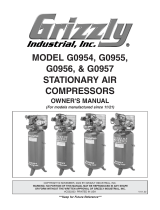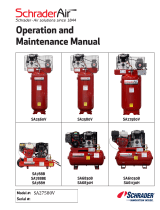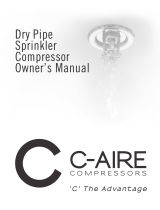NORTHSTAR 25654 Owner's manual
- Category
- Air compressors
- Type
- Owner's manual
This manual is also suitable for
NORTHSTAR 25654 Electric Portable Air Compressor is a powerful and versatile tool, perfect for a variety of tasks around the home, garage, or workshop. With its 2 HP motor and 20-gallon tank, this compressor can deliver up to 135 PSI of air pressure, making it ideal for powering air tools, inflating tires, or painting.
The NORTHSTAR 25654 is also equipped with a number of features that make it easy to use and maintain. These features include:
- Automatic start/stop system: This system automatically turns the compressor on when the air pressure drops below a certain level and turns it off when the tank is full. This helps to prevent the compressor from running unnecessarily and wasting energy.
NORTHSTAR 25654 Electric Portable Air Compressor is a powerful and versatile tool, perfect for a variety of tasks around the home, garage, or workshop. With its 2 HP motor and 20-gallon tank, this compressor can deliver up to 135 PSI of air pressure, making it ideal for powering air tools, inflating tires, or painting.
The NORTHSTAR 25654 is also equipped with a number of features that make it easy to use and maintain. These features include:
- Automatic start/stop system: This system automatically turns the compressor on when the air pressure drops below a certain level and turns it off when the tank is full. This helps to prevent the compressor from running unnecessarily and wasting energy.




















-
 1
1
-
 2
2
-
 3
3
-
 4
4
-
 5
5
-
 6
6
-
 7
7
-
 8
8
-
 9
9
-
 10
10
-
 11
11
-
 12
12
-
 13
13
-
 14
14
-
 15
15
-
 16
16
-
 17
17
-
 18
18
-
 19
19
-
 20
20
-
 21
21
-
 22
22
-
 23
23
-
 24
24
NORTHSTAR 25654 Owner's manual
- Category
- Air compressors
- Type
- Owner's manual
- This manual is also suitable for
NORTHSTAR 25654 Electric Portable Air Compressor is a powerful and versatile tool, perfect for a variety of tasks around the home, garage, or workshop. With its 2 HP motor and 20-gallon tank, this compressor can deliver up to 135 PSI of air pressure, making it ideal for powering air tools, inflating tires, or painting.
The NORTHSTAR 25654 is also equipped with a number of features that make it easy to use and maintain. These features include:
- Automatic start/stop system: This system automatically turns the compressor on when the air pressure drops below a certain level and turns it off when the tank is full. This helps to prevent the compressor from running unnecessarily and wasting energy.
Ask a question and I''ll find the answer in the document
Finding information in a document is now easier with AI
Related papers
-
NORTHSTAR Electric Air Compressor, 3.7 HP, 230 Volt, 1 Phase, 60-Gallon Vertical Tank Owner's manual
-
NORTHSTAR Gas-Powered Air Compressor, GX160 OHV Engine, 8-Gallon Twin Tank, 13.7 CFM @ 90 PSI Owner's manual
-
NORTHSTAR Gas-Powered Air Compressor Owner's manual
-
NORTHSTAR Gas-Powered Air Compressor, GX160 OHV Engine, 8-Gallon Twin Tank, 13.7 CFM @ 90 PSI Owner's manual
-
NORTHSTAR Portable Gas-Powered Air Compressor, 177cc OHV Engine, 20-Gallon Horizontal Tank, 13.7 CFM @ 90 PSI Owner's manual
-
NORTHSTAR Portable Gas-Powered Air Compressor, 163cc OHV Engine, 20-Gallon Horizontal Tank, 13.7 CFM @ 90 PSI Owner's manual
-
NORTHSTAR Portable Gas-Powered Air Compressor Owner's manual
-
NORTHSTAR ® Gas-Powered Air Compressor, e300 OHV Engine, 8-Gallon Twin Tank, 14.9 CFM @ 90 PSI Owner's manual
-
NORTHSTAR Portable Gas-Powered Air Compressor Owner's manual
-
NORTHSTAR Single-Stage Portable Electric Air Compressor Owner's manual
Other documents
-
Chicago Pneumatic 7.5 HP 80 Gallon Air Compressor RCP-7583V User manual
-
 Grizzly PRO G0957 Owner's manual
Grizzly PRO G0957 Owner's manual
-
Global Industrial B2811234 User manual
-
PROPOINT 8475014 Owner's manual
-
PROPOINT 8475022 Owner's manual
-
 SchraderAir SA6830H Operation and Maintenance Manual
SchraderAir SA6830H Operation and Maintenance Manual
-
North Star 47501 Owner's manual
-
 C-Aire S325H-HD Owner's manual
C-Aire S325H-HD Owner's manual
-
North Star M459382B.6 Owner's manual
-
North Star M51481A Owner's manual


























